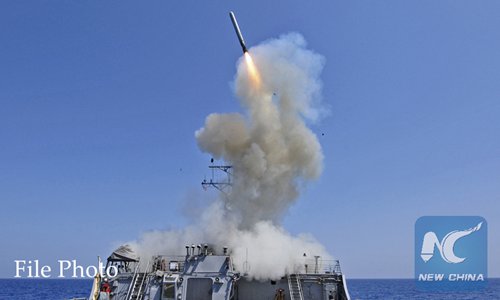
The guided-missile destroyer USS Barry launches a Tomahawk cruise missile from the ship's bow in the Mediterranean Sea in this U.S. Navy handout photo taken March 29, 2011. (Reuters Photo)
Responding to the plan announced at the NATO summit that the US intends to deploy long-range missiles in Germany by 2026, Kremlin spokesperson Dmitry Peskov warned on Saturday local time that European countries will be putting themselves at risk if they accept the deployment of long-range US weapons, adding that the move may make European capitals targets for Russia missiles in a repeat of a Cold War-like confrontation.
Asked by Russian state TV about the possibility of the US deploying hypersonic missiles to Europe, Peskov said that "we have enough potential to deter these missiles. But the capitals of these [European] states are potential victims," Reuters reported.
Peskov's remarks came following a joint statement issued by the US and Germany at NATO's 75th anniversary summit that the US will begin episodic deployments of the long-range fires capabilities of its Multi-Domain Task Force in Germany in 2026, as part of planning for enduring stationing of these capabilities in the future.
When fully developed, these conventional long-range fires units will include SM-6, Tomahawk, and developmental hypersonic weapons, which have significantly longer range than current land-based fires in Europe, per the White House.
The move would be the first of its kind since the Cold War, according to the BBC. Such missiles would have been banned under a 1988 treaty between the US and former Soviet Union, but the pact fell apart five years ago, the BBC reported.
The decision immediately drew a rebuke from Russia, with Russian Deputy Foreign Minister Sergei Ryabkov warning that Moscow would react with a "military response to the new threat," according to TASS news agency.
Peskov noted that throughout the Cold War, American missiles based in Europe were aimed at Russia, with Russian missiles aimed at Europe in return, making the continent's countries the chief victim of any potential conflict, according to Reuters.
He said: "Europe is now coming apart at the seams. This is not the best time for Europe. Therefore, in one way or another, history will repeat itself."
The Tomahawk missile and SM-6 are more likely stopgap measures, buying time for the US to research and develop hypersonic weapons. The ultimate intent behind the decision lies in the deployment of US hypersonic missiles that could better meet the actual needs of the US against Russia, according to a Chinese military expert who requested not to be named.
This is because, in countering Russia, Tomahawk missiles offer relatively weak penetration capabilities, the expert explained.
There is no doubt that the potential deployment of US hypersonic weapons in Germany would force Russia to join the arms race and enhance its hypersonic weapon strike coverage. As a countermeasure, Russia might further extend the range of its hypersonic missiles, allowing them to cover the entire European continent, including Germany, the military expert warned.
Russia has many options to counter US provocations. The decision to deploy US weapons to Germany might provoke Russia to deploy intermediate-range missiles in Kaliningrad as a countermeasure, which would completely offset the threat posed by Germany's deployment of US missiles, but leave Europe facing greater security risks, Cui Heng, a scholar from the Shanghai-based China National Institute for SCO International Exchange and Judicial Cooperation, told the Global Times on Sunday.
Chinese observers pointed out that the US policy would become the opposite of bringing security to Europe. Instead, it increasingly puts Europe at risk, causing significant harm, which aligns with the traditional US strategy of creating a heightened risk of attack to maintain control over its allies.
Deploying weapons in Europe ostensibly targets Russia, but in reality it treats European countries as US military bases, stripping them of their sovereignty, experts added.
Germany's agreement to this deployment enhances its own defense capabilities and strengthens German-American military and security cooperation. However, it also places Europe directly in the crosshairs of US-Russia strategic game. Such an escalation in deployment could also undermine the atmosphere for the crucial US-Russia strategic nuclear negotiations in 2025-26, Cui warned.
However, factors including the US presidential elections and the trajectory of the Russia-Ukraine military conflict could impact this deployment by 2026, several experts noted.

